Mapping and Assessing Groundwater Quality in Bourgogne-Franche-Comté (France): Toward Optimized Monitoring and Management of Groundwater Resource
Abstract
1. Introduction
2. Materials and Methods
2.1. Study Site: Bourgogne-Franche-Comté Region
2.2. Databases
2.3. Obtaining GWB Groups
- Data Conditioning: The data underwent a logarithmic transformation to approximate normal distributions and reduce the influence of extreme values. This conditioning, previously tested on similar datasets from the Occitanie [32], Provence-Alpes-Côte d’Azur [33], Auvergne-Rhône-Alpes [34], and Corsica regions [35], allows for a better analysis of variability sources.
- Sample Assignment: Each of the 3569 samples was assigned to a GWB based on its geographical coordinates and sampling depth.
- Principal Component Analysis (PCA): A PCA was performed on the log-transformed data to reduce the dimensionality of the data space, i.e., eliminate redundancies in the information carried by the parameters, and to identify variability sources [36]. The PCA, conducted by diagonalizing the correlation matrix, considers standardized variables, enabling the integration of parameters with diverse natures and units. Under these conditions, the factorial axes, orthogonal to each other, are associated with independent processes responsible for water quality variability. The first factorial axes, representing approximately 90% of the information contained in the dataset, are retained. The last factorial axes, explaining a small percentage of the variance, are eliminated as they are considered statistical noise.
- Calculation of Averages by GWB: Average values were calculated for each GWB on the retained factorial axes. At this stage, each GWB is characterized by a vector of dimension X, where X is the number of retained factorial axes.
- Agglomerative Hierarchical Clustering (AHC): An unsupervised AHC was applied to group GWBs based on their similarity [37,38,39]. This clustering aims to assemble GWBs into groups according to a similarity criterion in terms of correlation, considering all parameters. The relative similarities between GWBs were quantified using Euclidean distance, and the similarity levels at which GWBs were merged were used to construct a dendrogram. The number of clusters was determined through two guiding principles: 1—practical groundwater management considerations, which typically require between 5 and 15 distinct groups; 2—analysis of the “explained variance percentage vs. number of clusters” curve, where the elbow point (slope break) was selected as it provides the optimal balance between model simplicity (fewer clusters) and information retention (higher explained variance).
- Mapping of GWB Groups: Finally, the GWB groups were mapped in a GIS (Geographic Information System).
2.4. Parameter Classification
2.5. Analysis of GWB Groups and of Clustering Methodology
3. Results
3.1. Groundwater Bodies Grouping
3.2. Parameter Clustering
3.3. Characteristics of the Groups
3.3.1. Fecal Contamination and Nitrogen Pollution
3.3.2. Fecal Contamination and Associated Parameters
3.3.3. Turbidity and Water Minerality
3.3.4. Parameters Sensitive to Redox Conditions
3.4. Water Quality Homogeneity Within Groups
3.5. Discrimination of Groups 9 and 10
4. Discussion
4.1. Consistent Discrimination and Grouping of GWBs
- The relevance of the method used, which groups GWBs not only based on similar overall parameter characteristics (i.e., proximity in features) but also on correlations between these parameters (i.e., similar underlying mechanisms). At the same time, GWB groups with markedly different factorial planes reflect distinct mechanisms and variability sources from one group to another.
- Stability in chemical and microbiological characteristics within groups, with variability mainly linked to temporal quality fluctuations at the catchment scale [31].
4.2. Contamination in Line with Lithology and Land Use
4.3. Existence of Regional Structures Beyond Local Specificities
- The type of fertilizer (ammoniacal/nitrate forms).
- The quantity (aligned with crop needs).
- The application schedule (adjusted to the crop growth cycle throughout the agricultural season).
4.4. Applicability and Limitations of the Method
5. Conclusions
Author Contributions
Funding
Data Availability Statement
Conflicts of Interest
References
- Bhunia, G.S.; Shit, P.K.; Brahma, S. Chapter 19—Groundwater Conservation and Management: Recent Trends and Future Prospects. In Case Studies in Geospatial Applications to Groundwater Resources; Shit, P.K., Bhunia, G.S., Adhikary, P.P., Eds.; Elsevier: Amsterdam, The Netherlands, 2023; pp. 371–385. ISBN 978-0-323-99963-2. [Google Scholar]
- Kemper, K.E. Groundwater—From Development to Management. Hydrogeol. J. 2004, 12, 3–5. [Google Scholar] [CrossRef]
- Falkenmark, M.; Folke, C.; Foster, S.S.D.; Chilton, P.J. Groundwater: The Processes and Global Significance of Aquifer Degradation. Philos. Trans. R Soc. Lond. B 2003, 358, 1957–1972. [Google Scholar] [CrossRef]
- Motlagh, A.M.; Yang, Z.; Saba, H. Groundwater Quality. Water Environ. Res. 2020, 92, 1649–1658. [Google Scholar] [CrossRef]
- van der Gun, J. Chapter 24—Groundwater Resources Sustainability. In Global Groundwater; Mukherjee, A., Scanlon, B.R., Aureli, A., Langan, S., Guo, H., McKenzie, A.A., Eds.; Elsevier: Amsterdam, The Netherlands, 2021; pp. 331–345. ISBN 978-0-12-818172-0. [Google Scholar]
- Yuan, H.; Yang, S.; Wang, B. Hydrochemistry Characteristics of Groundwater with the Influence of Spatial Variability and Water Flow in Hetao Irrigation District, China. Environ. Sci. Pollut. Res. 2022, 29, 71150–71164. [Google Scholar] [CrossRef] [PubMed]
- Gao, Y.; Chen, J.; Qian, H.; Wang, H.; Ren, W.; Qu, W. Hydrogeochemical Characteristics and Processes of Groundwater in an over 2260 Year Irrigation District: A Comparison between Irrigated and Nonirrigated Areas. J. Hydrol. 2022, 606, 127437. [Google Scholar] [CrossRef]
- Sophocleous, M. Review: Groundwater Management Practices, Challenges, and Innovations in the High Plains Aquifer, USA—Lessons and Recommended Actions. Hydrogeol. J. 2010, 18, 559–575. [Google Scholar] [CrossRef]
- Ielpo, P.; Cassano, D.; Felice Uricchio, V.; Lopez, A.; Pappagallo, G.; Trizio, L.; de Gennaro, G. Identification of Pollution Sources and Classification of Apulia Region Groundwaters by Multivariate Statistical Methods and Neural Networks. Trans. ASABE 2013, 56, 1377–1386. [Google Scholar] [CrossRef]
- Doctor, D.H.; Alexander, E.C.; Petrič, M.; Kogovšek, J.; Urbanc, J.; Lojen, S.; Stichler, W. Quantification of Karst Aquifer Discharge Components during Storm Events through End-Member Mixing Analysis Using Natural Chemistry and Stable Isotopes as Tracers. Hydrogeol. J. 2006, 14, 1171–1191. [Google Scholar] [CrossRef]
- Woldt, W.; Bogardi, I. Ground Water Monitoring Network Design Using Multiple Criteria Decision Making and Geostatistics. J. Am. Water Resour. Assoc. 1992, 28, 45–62. [Google Scholar] [CrossRef]
- Bárdossy, A. Copula-Based Geostatistical Models for Groundwater Quality Parameters. Water Resour. Res. 2006, 42, W11416. [Google Scholar] [CrossRef]
- Sheikhy Narany, T.; Ramli, M.F.; Aris, A.Z.; Sulaiman, W.N.A.; Fakharian, K. Spatiotemporal Variation of Groundwater Quality Using Integrated Multivariate Statistical and Geostatistical Approaches in Amol-Babol Plain, Iran. Environ. Monit. Assess. 2014, 186, 5797–5815. [Google Scholar] [CrossRef] [PubMed]
- Masoud, A.A. Groundwater Quality Assessment of the Shallow Aquifers West of the Nile Delta (Egypt) Using Multivariate Statistical and Geostatistical Techniques. J. Afr. Earth Sci. 2014, 95, 123–137. [Google Scholar] [CrossRef]
- Machiwal, D.; Jha, M.K. Identifying Sources of Groundwater Contamination in a Hard-Rock Aquifer System Using Multivariate Statistical Analyses and GIS-Based Geostatistical Modeling Techniques. J. Hydrol. Reg. Stud. 2015, 4, 80–110. [Google Scholar] [CrossRef]
- Ayach, M.; Lazar, H.; Lamat, C.; Bousouis, A.; Touzani, M.; El Jarjini, Y.; Kacimi, I.; Valles, V.; Barbiero, L.; Morarech, M. Groundwaters in the Auvergne-Rhône-Alpes Region, France: Grouping Homogeneous Groundwater Bodies for Optimized Monitoring and Protection. Water 2024, 16, 869. [Google Scholar] [CrossRef]
- Lazar, H.; Ayach, M.; Barry, A.A.; Mohsine, I.; Touiouine, A.; Huneau, F.; Mori, C.; Garel, E.; Kacimi, I.; Valles, V.; et al. Groundwater Bodies in Corsica: A Critical Approach to GWBs Subdivision Based on Multivariate Water Quality Criteria. Hydrology 2023, 10, 213. [Google Scholar] [CrossRef]
- Jabrane, M.; Touiouine, A.; Valles, V.; Bouabdli, A.; Chakiri, S.; Mohsine, I.; El Jarjini, Y.; Morarech, M.; Duran, Y.; Barbiero, L. Search for a Relevant Scale to Optimize the Quality Monitoring of Groundwater Bodies in the Occitanie Region (France). Hydrology 2023, 10, 89. [Google Scholar] [CrossRef]
- Mohsine, I.; Kacimi, I.; Valles, V.; Leblanc, M.; El Mahrad, B.; Dassonville, F.; Kassou, N.; Bouramtane, T.; Abraham, S.; Touiouine, A.; et al. Differentiation of Multi-Parametric Groups of Groundwater Bodies through Discriminant Analysis and Machine Learning. Hydrology 2023, 10, 230. [Google Scholar] [CrossRef]
- Tiouiouine, A.; Jabrane, M.; Kacimi, I.; Morarech, M.; Bouramtane, T.; Bahaj, T.; Yameogo, S.; Rezende-Filho, A.T.; Dassonville, F.; Moulin, M.; et al. Determining the Relevant Scale to Analyze the Quality of Regional Groundwater Resources While Combining Groundwater Bodies, Physicochemical and Biological Databases in Southeastern France. Water 2020, 12, 3476. [Google Scholar] [CrossRef]
- Chery, L.; Laurent, A.; Vincent, B.; Tracol, R. Echanges SISE-Eaux/ADES: Identification Des Protocoles Compatibles Avec Les Scénarios d’échange SANDRE; Office National de l’Eau et des Milieux Aquatiques: Bron, France, 2011. [Google Scholar]
- Gran-Aymeric, L. Un Portail National Sur La Qualite Des Eaux Destinees a La Consommation Humaine. Tech. Sci. Méthodes 2010, 12, 45–48. [Google Scholar] [CrossRef]
- John, D.E.; Rose, J.B. Review of Factors Affecting Microbial Survival in Groundwater. Environ. Sci. Technol. 2005, 39, 7345–7356. [Google Scholar] [CrossRef]
- Pachepsky, Y.A.; Shelton, D.R. Escherichia Coli and Fecal Coliforms in Freshwater and Estuarine Sediments. Crit. Rev. Environ. Sci. Technol. 2011, 41, 1067–1110. [Google Scholar] [CrossRef]
- Pandey, P.K.; Kass, P.H.; Soupir, M.L.; Biswas, S.; Singh, V.P. Contamination of Water Resources by Pathogenic Bacteria. AMB Express 2014, 4, 51. [Google Scholar] [CrossRef] [PubMed]
- Bousouis, A.; Bouabdli, A.; Ayach, M.; Ravung, L.; Valles, V.; Barbiero, L. The Multi-Parameter Mapping of Groundwater Quality in the Bourgogne-Franche-Comté Region (France) for Spatially Based Monitoring Management. Sustainability 2024, 16, 8503. [Google Scholar] [CrossRef]
- European Commission. Directive 2006/118/EC of the European Parliament and of the Council of 12 December 2006 on the Protection of Groundwater against Pollution and Deterioration. Off. J. Eur. Union 2006, 372, 19–31. [Google Scholar]
- Wendland, F.; Blum, A.; Coetsiers, M.; Gorova, R.; Griffioen, J.; Grima, J.; Hinsby, K.; Kunkel, R.; Marandi, A.; Melo, T.; et al. European Aquifer Typology: A Practical Framework for an Overview of Major Groundwater Composition at European Scale. Environ. Geol. 2008, 55, 77–85. [Google Scholar] [CrossRef]
- European Commission. Guidance Document No. 22. Guidance on Implementing the Geographical Information System (GIS) Elements of the EU Water Policy. Tools and Services for Reporting Under RBMP Within WISE. Guidance on Reporting of Spatial Data for the WFD (RBMP); Atkins: London, UK, 2009. [Google Scholar]
- Duscher, K. Compilation of a Groundwater Body GIS Reference Layer. In Proceedings of the Presentation at the WISE GIS Workshop, Copenhagen, Denmark, 16–17 November 2010. [Google Scholar]
- Bousouis, A.; Bouabdli, A.; Ayach, M.; Lazar, H.; Ravung, L.; Valles, V.; Barbiero, L. Discrimination of Spatial and Temporal Variabilities in the Analysis of Groundwater Databases: Application to the Bourgogne-Franche-Comté Region, France. Water 2025, 17, 384. [Google Scholar] [CrossRef]
- Jabrane, M.; Touiouine, A.; Bouabdli, A.; Chakiri, S.; Mohsine, I.; Valles, V.; Barbiero, L. Data Conditioning Modes for the Study of Groundwater Resource Quality Using a Large Physico-Chemical and Bacteriological Database, Occitanie Region, France. Water 2023, 15, 84. [Google Scholar] [CrossRef]
- Mohsine, I.; Kacimi, I.; Abraham, S.; Valles, V.; Barbiero, L.; Dassonville, F.; Bahaj, T.; Kassou, N.; Touiouine, A.; Jabrane, M.; et al. Exploring Multiscale Variability in Groundwater Quality: A Comparative Analysis of Spatial and Temporal Patterns via Clustering. Water 2023, 15, 1603. [Google Scholar] [CrossRef]
- Ayach, M.; Lazar, H.; Bousouis, A.; Touiouine, A.; Kacimi, I.; Valles, V.; Barbiero, L. Multi-Parameter Analysis of Groundwater Resources Quality in the Auvergne-Rhône-Alpes Region (France) Using a Large Database. Resources 2023, 12, 143. [Google Scholar] [CrossRef]
- Lazar, H.; Ayach, M.; Bousouis, A.; Huneau, F.; Mori, C.; Garel, E.; Kacimi, I.; Valles, V.; Barbiero, L. Multivariate and Spatial Study and Monitoring Strategies of Groundwater Quality for Human Consumption in Corsica. Hydrology 2024, 11, 197. [Google Scholar] [CrossRef]
- Helena, B.; Pardo, R.; Vega, M.; Barrado, E.; Fernandez, J.M.; Fernandez, L. Temporal Evolution of Groundwater Composition in an Alluvial Aquifer (Pisuerga River, Spain) by Principal Component Analysis. Water Res. 2000, 34, 807–816. [Google Scholar] [CrossRef]
- Bouguettaya, A.; Yu, Q.; Liu, X.; Zhou, X.; Song, A. Efficient Agglomerative Hierarchical Clustering. Expert Syst. Appl. 2015, 42, 2785–2797. [Google Scholar] [CrossRef]
- Suk, H.; Lee, K.-K. Characterization of a Ground Water Hydrochemical System Through Multivariate Analysis: Clustering into Ground Water Zones. Groundwater 1999, 37, 358–366. [Google Scholar] [CrossRef]
- Madhulatha, T.S. An Overview on Clustering Methods. IOSR J. Eng. 2012, 2, 719–725. [Google Scholar] [CrossRef]
- Huberty, C.J. Discriminant Analysis. Rev. Educ. Res. 1975, 45, 543–598. [Google Scholar] [CrossRef]
- Amiri, V.; Nakagawa, K. Using a Linear Discriminant Analysis (LDA)-Based Nomenclature System and Self-Organizing Maps (SOM) for Spatiotemporal Assessment of Groundwater Quality in a Coastal Aquifer. J. Hydrol. 2021, 603, 127082. [Google Scholar] [CrossRef]
- Bradley, A.P. The Use of the Area under the ROC Curve in the Evaluation of Machine Learning Algorithms. Pattern Recognit. 1997, 30, 1145–1159. [Google Scholar] [CrossRef]
- Rish, I. An Empirical Study of the Naive Bayes Classifier. In Proceedings of the IJCAI 2001 workshop on empirical methods in artificial intelligence, Seattle, WA, USA, 4–6 August 2001; pp. 41–46. [Google Scholar]
- Achen, C.H. What Does “Explained Variance” Explain?: Reply. Political Anal. 1990, 2, 173–184. [Google Scholar] [CrossRef]
- Miles, J. R Squared, Adjusted R Squared. In Wiley StatsRef: Statistics Reference Online; Wiley: Hoboken, NJ, USA, 2014; ISBN 9781118445112. [Google Scholar]
- Abbas, A.; Baek, S.; Silvera, N.; Soulileuth, B.; Pachepsky, Y.; Ribolzi, O.; Boithias, L.; Cho, K.H. In-Stream Escherichia coli Modeling Using High-Temporal-Resolution Data with Deep Learning and Process-Based Models. Hydrol. Earth Syst. Sci. 2021, 25, 6185–6202. [Google Scholar] [CrossRef]
- Chave, P. The EU Water Framework Directive—An Introduction; IWA Publishing: London, UK, 2007; ISBN 9781780402239. [Google Scholar]
- Kallis, G.; Butler, D. The EU Water Framework Directive: Measures and Implications. Water Policy 2001, 3, 125–142. [Google Scholar] [CrossRef]
- Wendland, F.; Berthold, G.; Blum, A.; Elsass, P.; Fritsche, J.-G.; Kunkel, R.; Wolter, R. Derivation of Natural Background Levels and Threshold Values for Groundwater Bodies in the Upper Rhine Valley (France, Switzerland and Germany). Desalination 2008, 226, 160–168. [Google Scholar] [CrossRef]
- Pouey, J.; Galey, C.; Chesneau, J.; Jones, G.; Franques, N.; Beaudeau, P.; Groupe des Référents Régionaux EpiGEH; Mouly, D. Implementation of a National Waterborne Disease Outbreak Surveillance System: Overview and Preliminary Results, France, 2010 to 2019. Eurosurveillance 2021, 26, 2001466. [Google Scholar] [CrossRef]
- Beaudeau, P.; Pascal, M.; Mouly, D.; Galey, C.; Thomas, O. Health Risks Associated with Drinking Water in a Context of Climate Change in France: A Review of Surveillance Requirements. J. Water Clim. Change 2011, 2, 230–246. [Google Scholar] [CrossRef]
- Irish Working Group. Groundwater Body Delineation in the Republic of Ireland; GSI: Dublin, Ireland, 2005. [Google Scholar]
- Moral, F.; Cruz-Sanjulián, J.J.; Olías, M. Geochemical Evolution of Groundwater in the Carbonate Aquifers of Sierra de Segura (Betic Cordillera, Southern Spain). J. Hydrol. 2008, 360, 281–296. [Google Scholar] [CrossRef]
- Psomas, A.; Bariamis, G.; Roy, S.; Rouillard, J.; Stein, U. Comparative Study on Quantitative and Chemical Status of Groundwater Bodies: Study of the Impacts of Pressures on Groundwater in Europe; Service Contract 315/B2020/EEA.58185; European Environment Agency: København, Denmark, 2021. [Google Scholar]
- Urresti-Estala, B.; Carrasco-Cantos, F.; Vadillo-Pérez, I.; Jiménez-Gavilán, P. Determination of Background Levels on Water Quality of Groundwater Bodies: A Methodological Proposal Applied to a Mediterranean River Basin (Guadalhorce River, Málaga, Southern Spain). J. Environ. Manag. 2013, 117, 121–130. [Google Scholar] [CrossRef] [PubMed]
- Martínez-Navarrete, C.; Jiménez-Madrid, A.; Sánchez-Navarro, I.; Carrasco-Cantos, F.; Moreno-Merino, L. Conceptual Framework for Protecting Groundwater Quality. Int. J. Water Resour. Dev. 2011, 27, 227–243. [Google Scholar] [CrossRef]
- De Stefano, L.; Fornés, J.M.; López-Geta, J.A.; Villarroya, F. Groundwater Use in Spain: An Overview in Light of the EU Water Framework Directive. Int. J. Water Resour. Dev. 2015, 31, 640–656. [Google Scholar] [CrossRef]
- Onorati, G.; Di Meo, T.; Bussettini, M.; Fabiani, C.; Farrace, M.G.; Fava, A.; Ferronato, A.; Mion, F.; Marchetti, G.; Martinelli, A.; et al. Groundwater Quality Monitoring in Italy for the Implementation of the EU Water Framework Directive. Phys. Chem. Earth Parts A/B/C 2006, 31, 1004–1014. [Google Scholar] [CrossRef]
- Richter, S.; Völker, J.; Borchardt, D.; Mohaupt, V. The Water Framework Directive as an Approach for Integrated Water Resources Management: Results from the Experiences in Germany on Implementation, and Future Perspectives. Environ. Earth Sci. 2013, 69, 719–728. [Google Scholar] [CrossRef]
- Shepley, M.G.; Whiteman, M.I.; Hulme, P.J.; Grout, M.W. Introduction: Groundwater Resources Modelling: A Case Study from the UK. Geol. Soc. Lond. Spec. Publ. 2012, 364, 1–6. [Google Scholar] [CrossRef]
- Mihaylova, V.; Yotova, G.; Kudłak, B.; Venelinov, T.; Tsakovski, S. Chemometric Evaluation of WWTPs’ Wastewaters and Receiving Surface Waters in Bulgaria. Water 2022, 14, 521. [Google Scholar] [CrossRef]
- Balzarolo, D.; Lazzara, P.; Colonna, P.; Becciu, P.; Rana, G. The Implementation of the Water Framework Directive in Italy. Options Mediterrannées 2011, 98, 155–167. [Google Scholar]
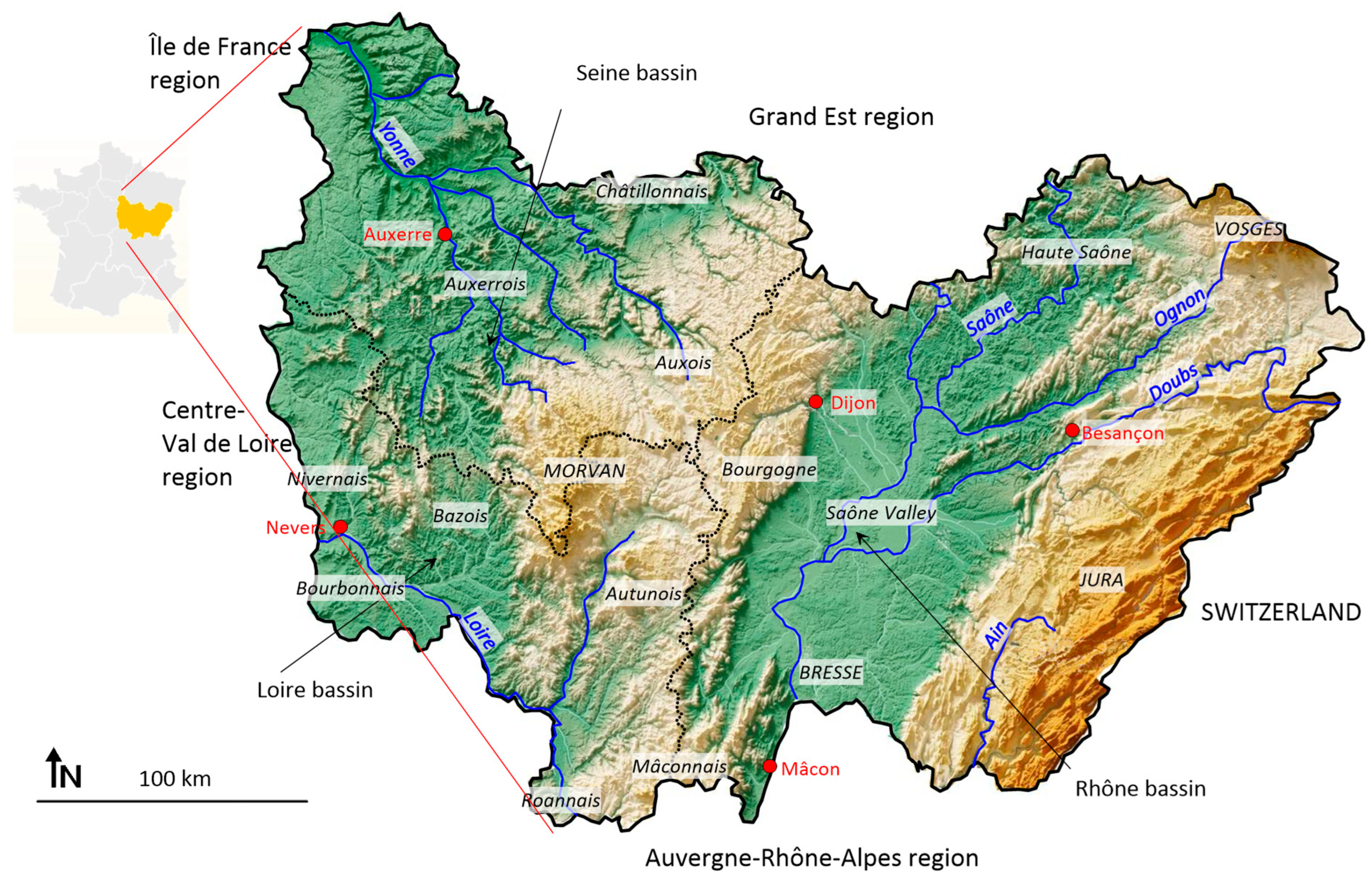
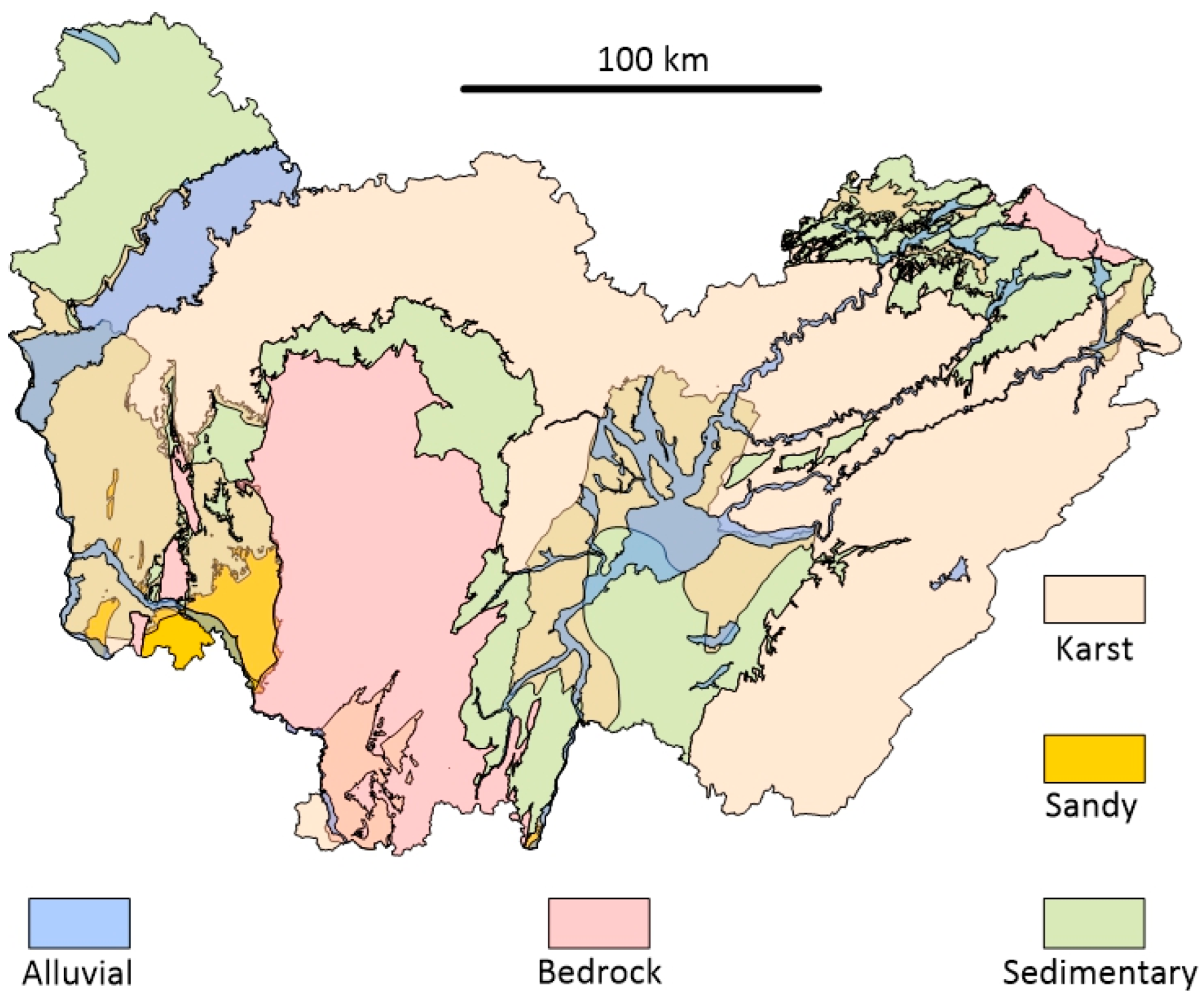
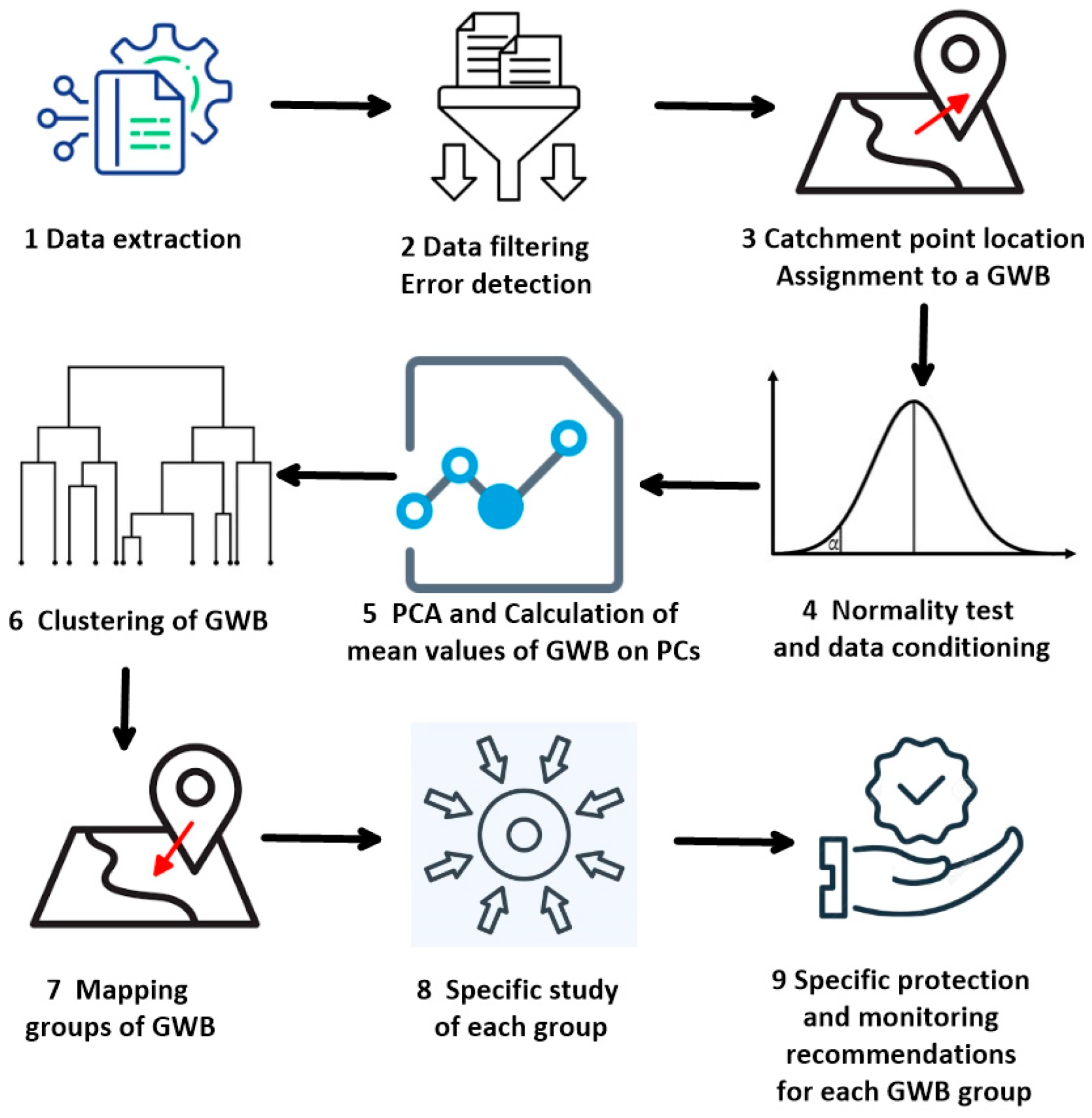
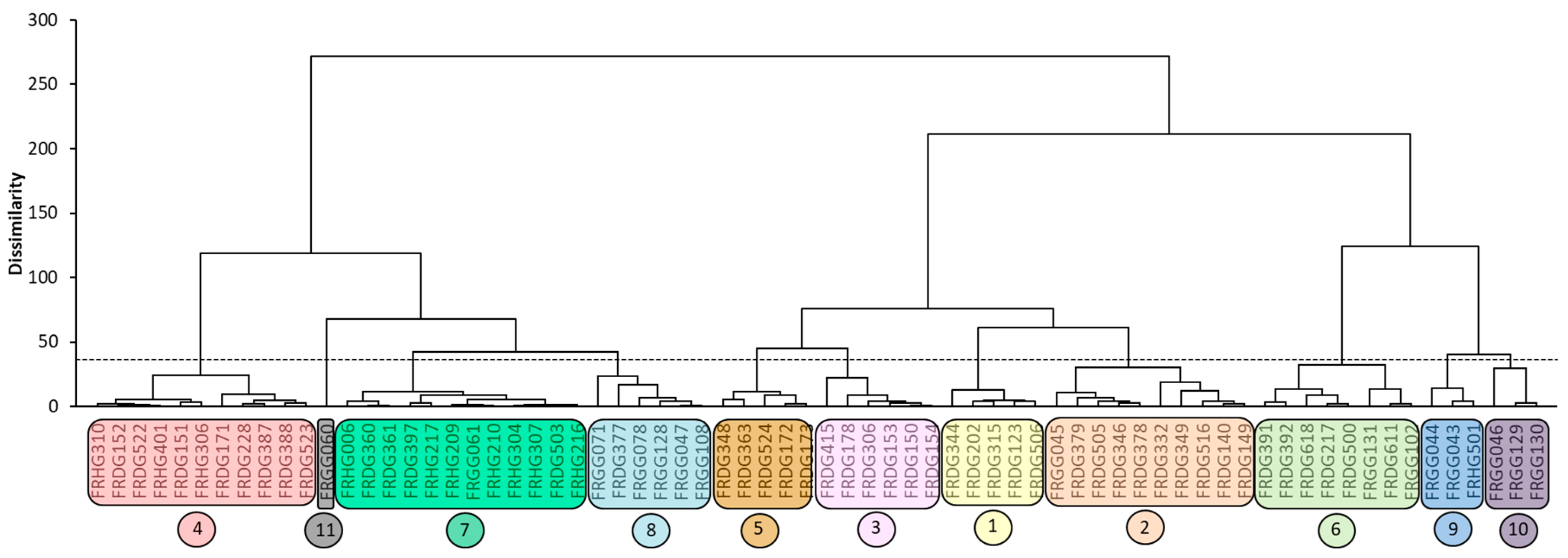
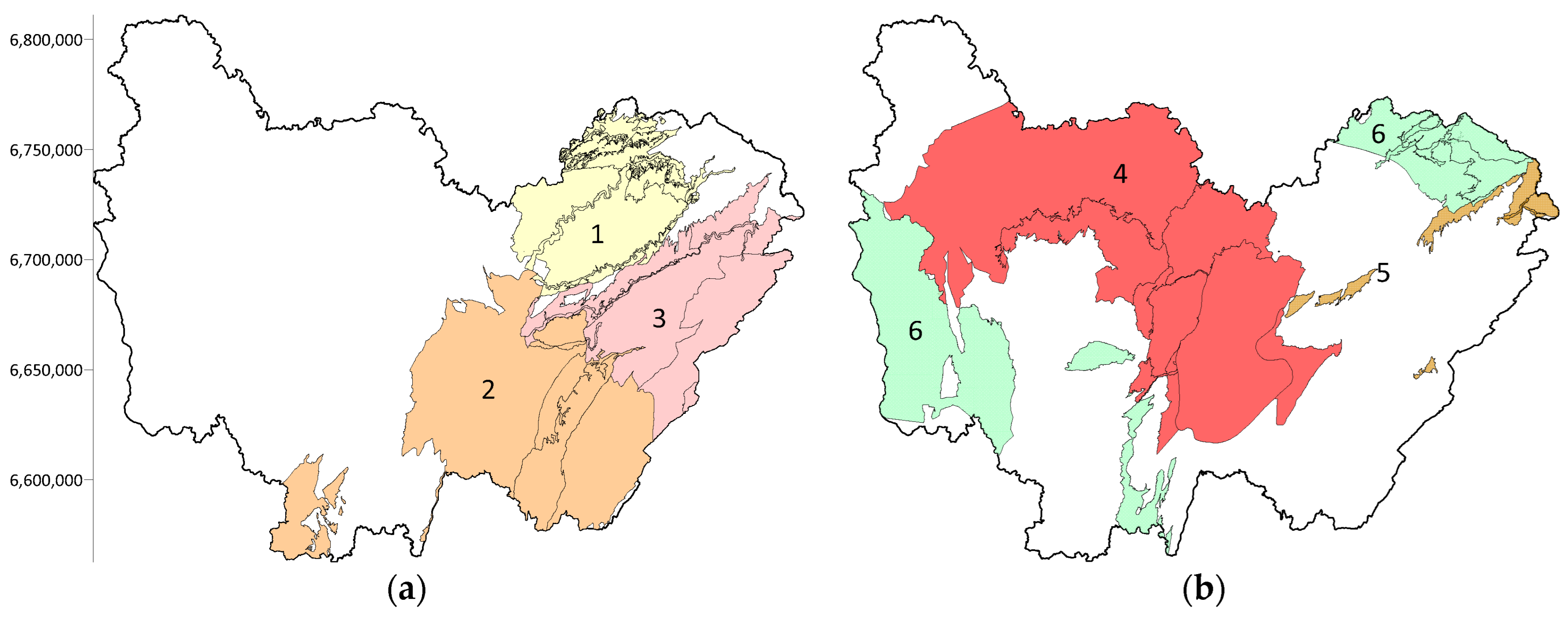
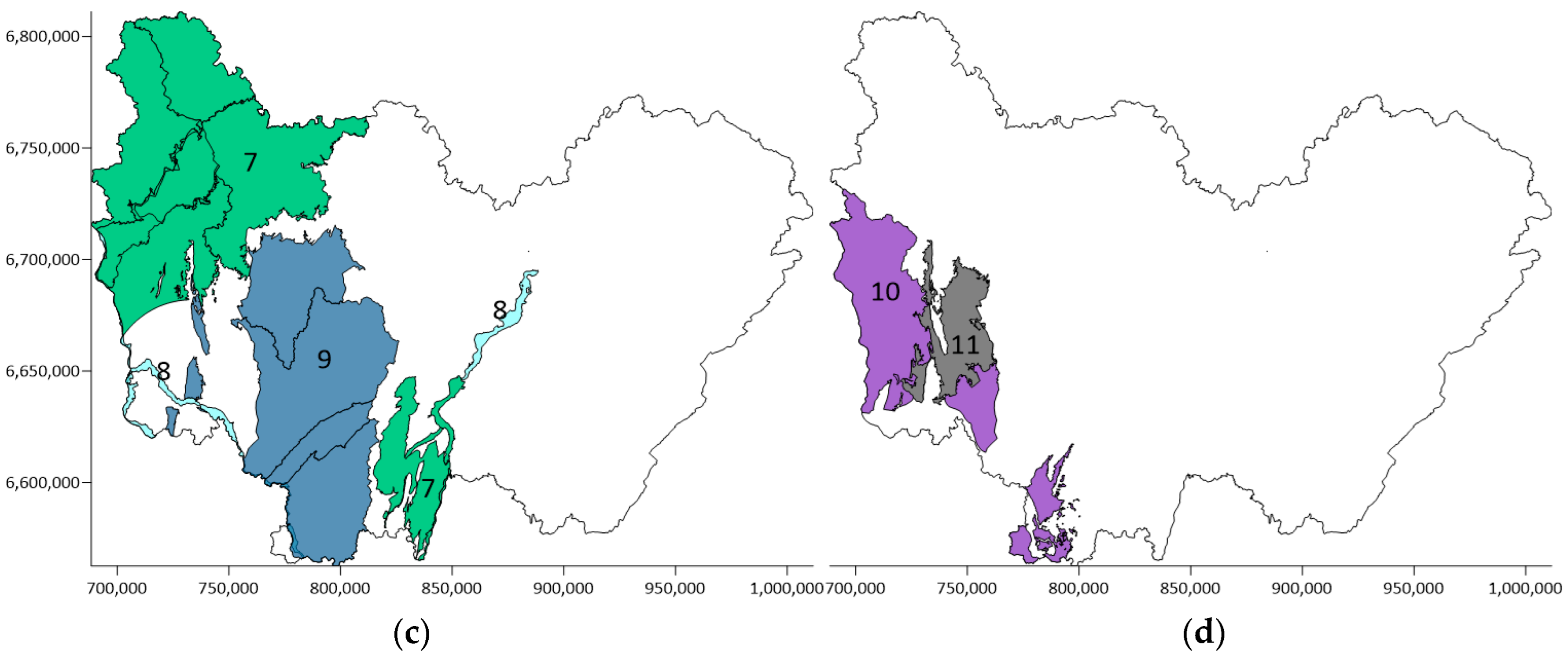
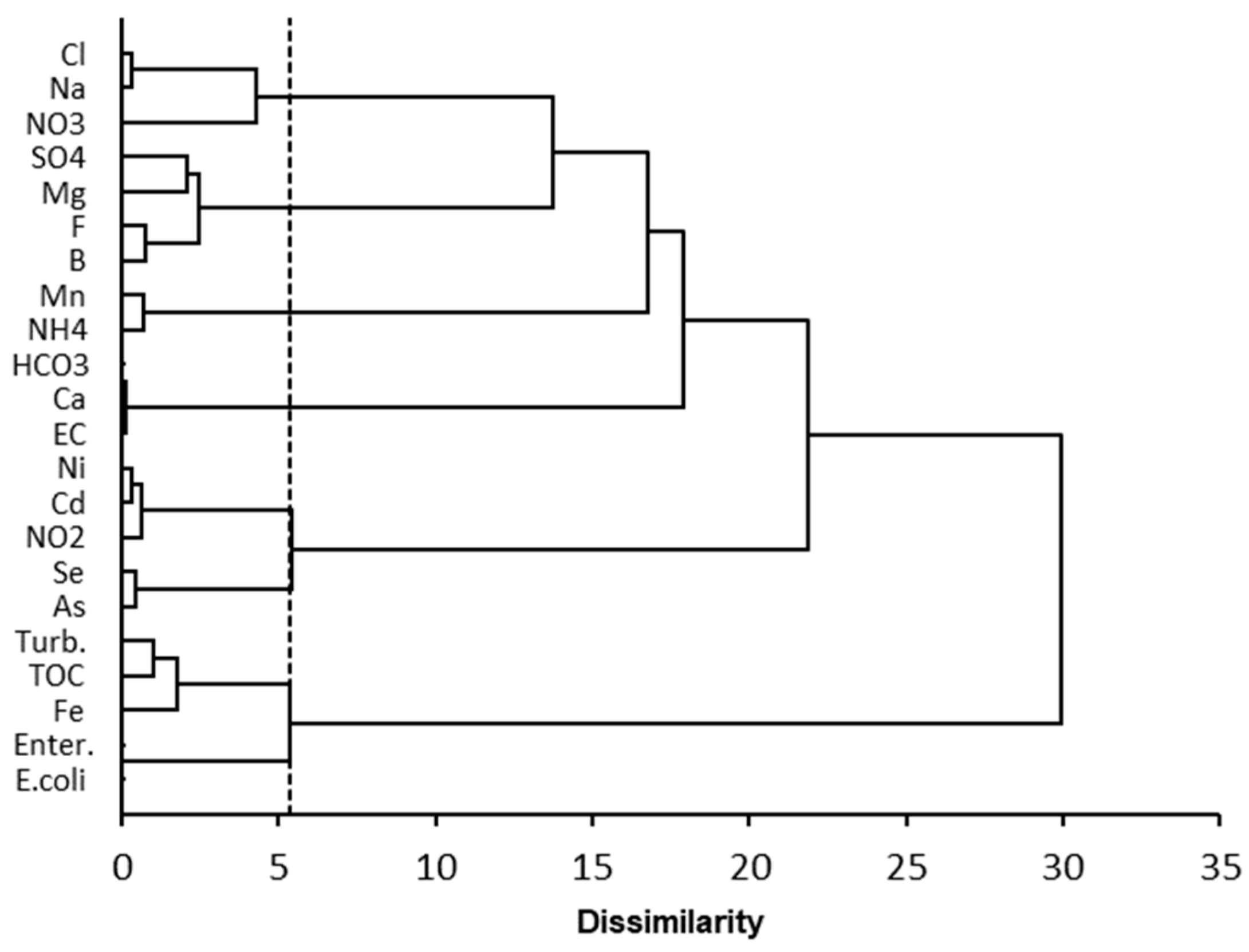
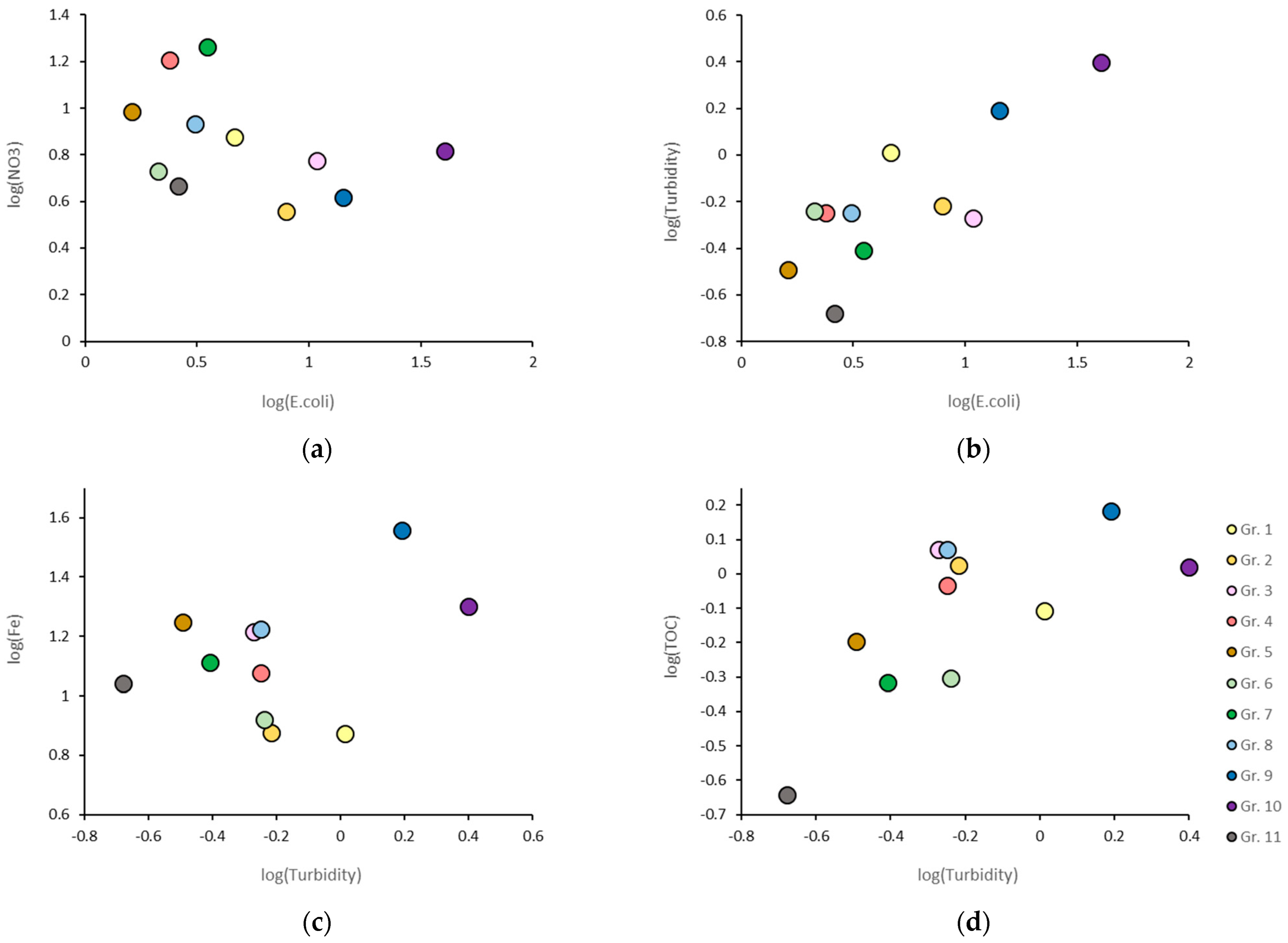

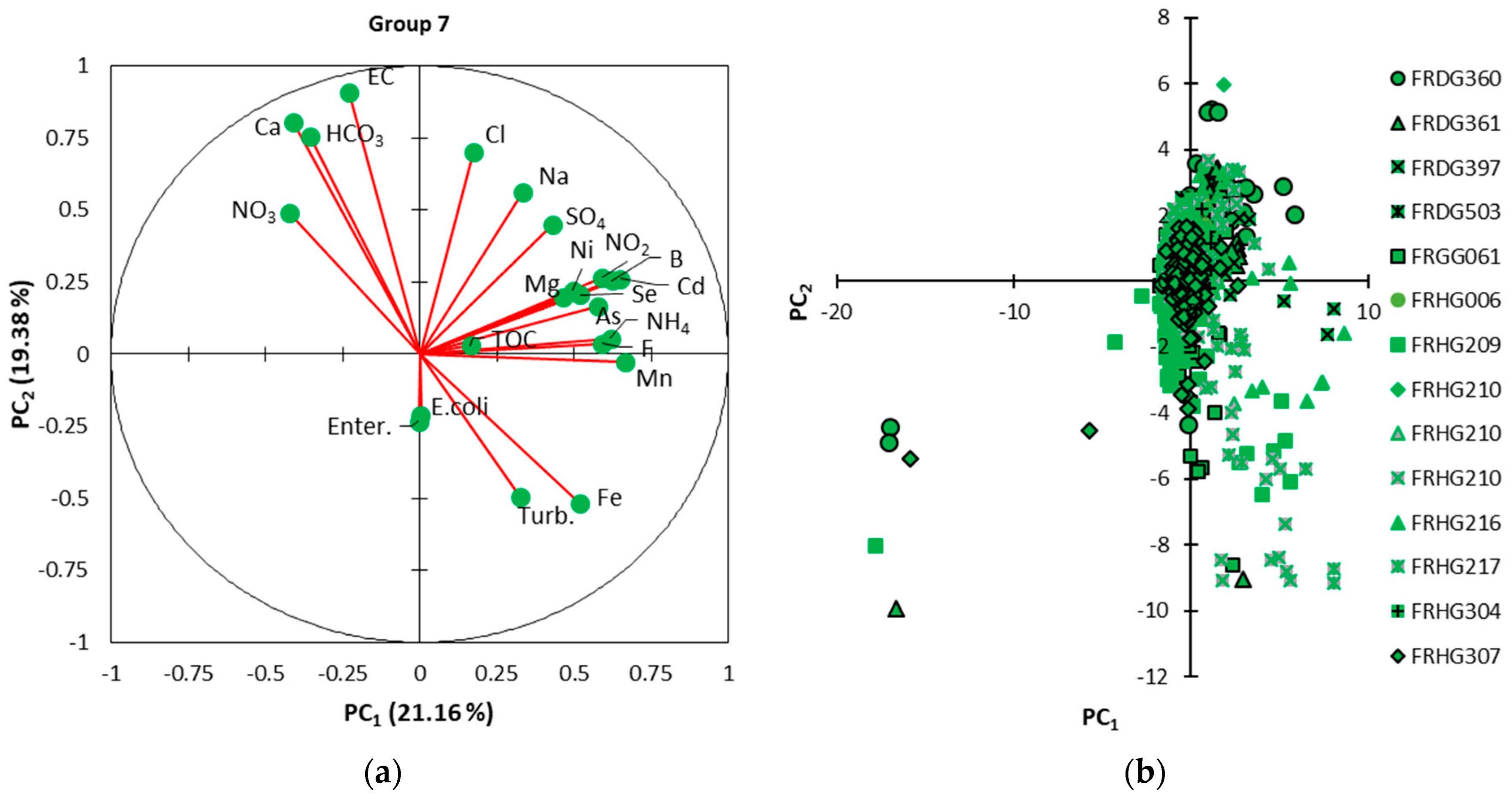

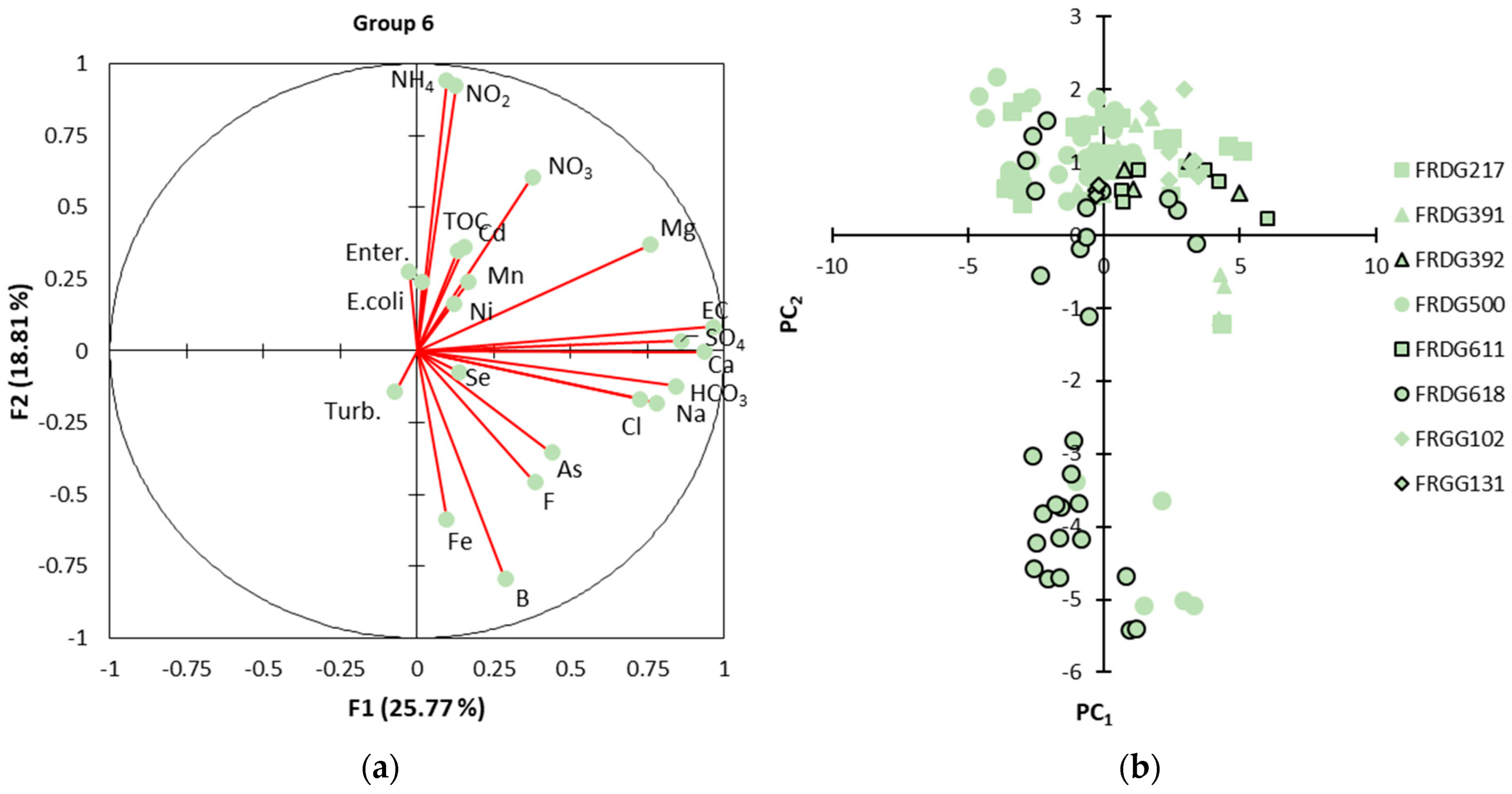
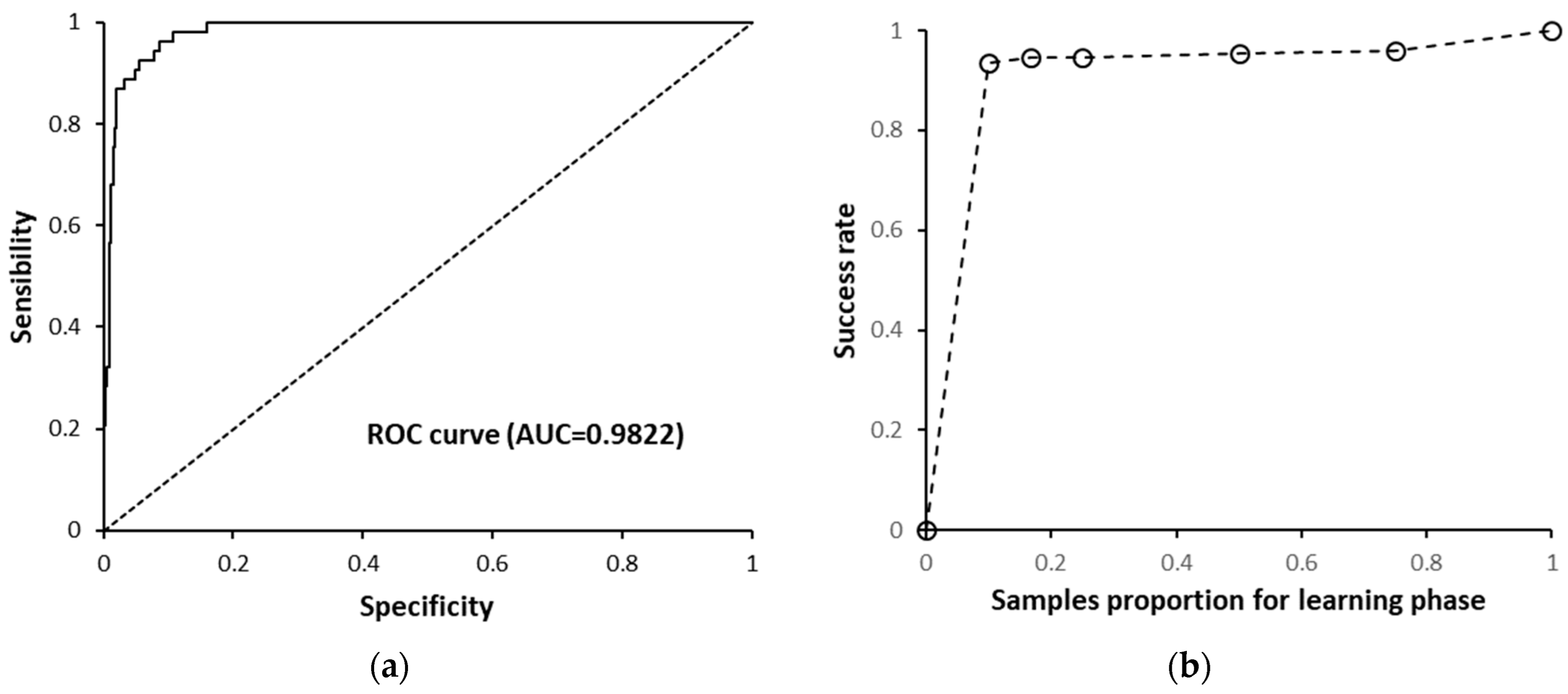
| Group | EC | E.coli | Enter. | NH4 | As | Na | Ca | Mg | Cl | SO4 | HCO3 |
|---|---|---|---|---|---|---|---|---|---|---|---|
| 1 | 2.636 | 0.668 | 0.592 | −1.175 | 0.347 | 0.576 | 1.861 | 0.767 | 0.824 | 1.112 | 2.361 |
| 2 | 2.627 | 0.896 | 0.769 | −1.468 | 0.271 | 0.368 | 1.904 | 0.443 | 0.608 | 0.753 | 2.391 |
| 3 | 2.678 | 1.035 | 0.877 | −1.605 | 0.420 | 0.539 | 1.956 | 0.510 | 0.776 | 0.858 | 2.439 |
| 4 | 2.734 | 0.377 | 0.295 | −1.608 | 0.683 | 0.587 | 2.014 | 0.503 | 0.874 | 1.121 | 2.472 |
| 5 | 2.653 | 0.209 | 0.193 | −1.640 | 0.400 | 0.850 | 1.869 | 0.557 | 1.038 | 0.885 | 2.357 |
| 6 | 1.939 | 0.326 | 0.308 | −1.303 | 0.516 | 0.461 | 0.862 | 0.289 | 0.669 | 0.722 | 1.379 |
| 7 | 2.735 | 0.546 | 0.411 | −1.221 | 0.482 | 0.746 | 2.006 | 0.405 | 1.104 | 1.100 | 2.455 |
| 8 | 2.567 | 0.490 | 0.398 | −1.221 | 0.575 | 0.958 | 1.714 | 0.718 | 1.120 | 1.302 | 2.198 |
| 9 | 2.027 | 1.151 | 0.993 | −1.198 | 0.610 | 0.718 | 0.959 | 0.195 | 0.754 | 0.672 | 1.490 |
| 10 | 2.610 | 1.608 | 1.066 | −1.205 | 0.491 | 0.713 | 1.818 | 0.492 | 0.937 | 1.075 | 2.289 |
| 11 | 2.798 | 0.418 | 0.301 | −1.222 | 1.121 | 1.286 | 1.870 | 1.056 | 1.399 | 1.449 | 2.415 |
| Group | NO3 | Fe | Mn | B | F | NO2 | TOC | Turb. | Se | Cd | Ni |
| 1 | 0.875 | 0.874 | 1.301 | −1.927 | −1.045 | −1.703 | −0.108 | 0.012 | 0.266 | 0.138 | 0.438 |
| 2 | 0.559 | 0.877 | 0.695 | −2.077 | −1.253 | −2.331 | 0.026 | −0.218 | 0.258 | 0.149 | 0.428 |
| 3 | 0.773 | 1.216 | 0.758 | −1.599 | −1.091 | −1.952 | 0.072 | −0.271 | 0.295 | 0.033 | 0.416 |
| 4 | 1.208 | 1.076 | 0.520 | −2.047 | −1.188 | −1.673 | −0.033 | −0.249 | 0.678 | 0.299 | 0.539 |
| 5 | 0.986 | 1.249 | 0.803 | −1.480 | −1.099 | −1.930 | −0.198 | −0.492 | 0.302 | 0.019 | 0.384 |
| 6 | 0.730 | 0.920 | 1.063 | −1.968 | −1.096 | −1.724 | −0.305 | −0.239 | 0.289 | 0.152 | 0.479 |
| 7 | 1.263 | 1.111 | 1.094 | −1.883 | −1.111 | −1.684 | −0.317 | −0.409 | 0.477 | 0.299 | 0.774 |
| 8 | 0.932 | 1.225 | 1.409 | −1.697 | −0.979 | −1.654 | 0.072 | −0.248 | 0.559 | 0.301 | 0.684 |
| 9 | 0.617 | 1.557 | 1.356 | −1.976 | −1.004 | −1.617 | 0.183 | 0.190 | 0.518 | 0.298 | 0.718 |
| 10 | 0.817 | 1.300 | 1.313 | −1.767 | −1.105 | −1.621 | 0.020 | 0.398 | 0.452 | 0.285 | 0.750 |
| 11 | 0.665 | 1.041 | 1.113 | −1.339 | 0.144 | −1.678 | −0.642 | −0.678 | 0.477 | 0.315 | 0.803 |
| Group 7 | Group 9 | Group 6 | ||||
|---|---|---|---|---|---|---|
| Parameter | GWB | Catch. Point | GWB | Catch. Point | GWB | Catch. Point |
| EC | 0.08 | 0.86 | 0.02 | 0.97 | 0.25 | 0.98 |
| E.coli | 0.05 | 0.60 | 0.08 | 0.88 | 0.05 | 0.78 |
| Enter | 0.05 | 0.57 | 0.10 | 0.91 | 0.04 | 0.62 |
| NH4 | 0.04 | 0.75 | 0.03 | 0.53 | 0.34 | 0.85 |
| As | 0.05 | 0.77 | 0.00 | 0.76 | 0.01 | 0.76 |
| Na | 0.44 | 0.86 | 0.02 | 0.90 | 0.46 | 0.97 |
| Ca | 0.03 | 0.84 | 0.03 | 0.98 | 0.20 | 0.97 |
| Mg | 0.42 | 0.91 | 0.07 | 0.96 | 0.28 | 0.99 |
| Cl | 0.31 | 0.83 | 0.04 | 0.90 | 0.31 | 0.89 |
| SO4 | 0.31 | 0.89 | 0.09 | 0.95 | 0.33 | 0.97 |
| HCO3 | 0.04 | 0.83 | 0.02 | 0.96 | 0.11 | 0.98 |
| NO3 | 0.10 | 0.86 | 0.11 | 0.64 | 0.49 | 0.96 |
| Fe | 0.09 | 0.71 | 0.10 | 0.85 | 0.08 | 0.58 |
| Mn | 0.15 | 0.71 | 0.15 | 0.79 | 0.24 | 0.71 |
| B | 0.23 | 0.79 | 0.01 | 0.69 | 0.13 | 0.71 |
| F | 0.28 | 0.79 | 0.09 | 0.91 | 0.12 | 0.95 |
| NO2 | 0.02 | 0.93 | 0.05 | 0.70 | 0.36 | 0.82 |
| TOC | 0.12 | 0.66 | 0.15 | 0.95 | 0.19 | 0.48 |
| Turb. | 0.09 | 0.70 | 0.17 | 0.86 | 0.12 | 0.71 |
| Se | 0.02 | 0.86 | 0.05 | 0.93 | 0.13 | 0.54 |
| Cd | 0.02 | 1.00 | 0.00 | 1.00 | 0.21 | 0.60 |
| Ni | 0.02 | 0.77 | 0.03 | 1.00 | 0.15 | 0.56 |
| from\to | 9 | 10 | Total | % Correct |
|---|---|---|---|---|
| 9 | 334 | 13 | 347 | 96.25% |
| 10 | 6 | 47 | 53 | 88.68% |
| Total | 340 | 60 | 400 | 95.25% |
| Param. | F1 | Param. | F1 | Param. | F1 | Param. | F1 |
|---|---|---|---|---|---|---|---|
| EC | 1.364 | Na | 0.211 | HCO3 | −0.597 | F | −0.382 |
| E.coli | 0.754 | Ca | 0.527 | NO3 | −0.382 | NO2 | 0.023 |
| Enter. | −0.351 | Mg | −0.254 | Fe | 0.216 | TOC | −0.842 |
| NH4 | −0.018 | Cl | −0.030 | Mn | −0.119 | Turb. | 0.472 |
| As | −0.356 | SO4 | −0.178 | B | 0.247 |
Disclaimer/Publisher’s Note: The statements, opinions and data contained in all publications are solely those of the individual author(s) and contributor(s) and not of MDPI and/or the editor(s). MDPI and/or the editor(s) disclaim responsibility for any injury to people or property resulting from any ideas, methods, instructions or products referred to in the content. |
© 2025 by the authors. Licensee MDPI, Basel, Switzerland. This article is an open access article distributed under the terms and conditions of the Creative Commons Attribution (CC BY) license (https://creativecommons.org/licenses/by/4.0/).
Share and Cite
Bousouis, A.; Ayach, M.; El Jarjini, Y.; Mohsine, I.; Ravung, L.; Chakiri, S.; Bouabdli, A.; Valles, V.; Barbiero, L. Mapping and Assessing Groundwater Quality in Bourgogne-Franche-Comté (France): Toward Optimized Monitoring and Management of Groundwater Resource. Water 2025, 17, 1396. https://doi.org/10.3390/w17091396
Bousouis A, Ayach M, El Jarjini Y, Mohsine I, Ravung L, Chakiri S, Bouabdli A, Valles V, Barbiero L. Mapping and Assessing Groundwater Quality in Bourgogne-Franche-Comté (France): Toward Optimized Monitoring and Management of Groundwater Resource. Water. 2025; 17(9):1396. https://doi.org/10.3390/w17091396
Chicago/Turabian StyleBousouis, Abderrahim, Meryem Ayach, Youssouf El Jarjini, Ismail Mohsine, Laurence Ravung, Saïd Chakiri, Abdelhak Bouabdli, Vincent Valles, and Laurent Barbiero. 2025. "Mapping and Assessing Groundwater Quality in Bourgogne-Franche-Comté (France): Toward Optimized Monitoring and Management of Groundwater Resource" Water 17, no. 9: 1396. https://doi.org/10.3390/w17091396
APA StyleBousouis, A., Ayach, M., El Jarjini, Y., Mohsine, I., Ravung, L., Chakiri, S., Bouabdli, A., Valles, V., & Barbiero, L. (2025). Mapping and Assessing Groundwater Quality in Bourgogne-Franche-Comté (France): Toward Optimized Monitoring and Management of Groundwater Resource. Water, 17(9), 1396. https://doi.org/10.3390/w17091396








